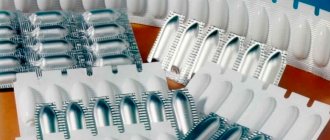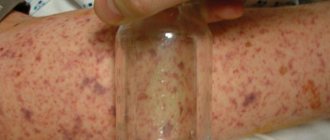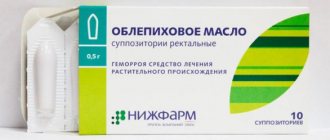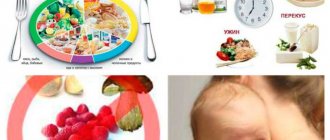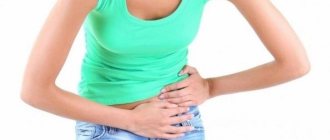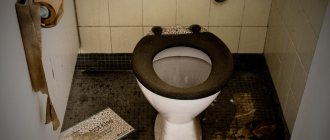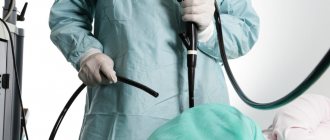Causes of constipation and its consequences
The structure of the intestines
The first 2 days after a cesarean section, the intestines are empty - an enema is given before the operation, and in the first days after it you cannot eat anything except chocolate. Next, puree soups, porridges, vegetables, and kefir are gradually introduced. Therefore, the absence of stool for up to 4–5 days after surgery is physiological.
If bowel movements do not occur for a longer period of time, or there are abdominal pains, false urges to defecate, or bloating, you should immediately report this to the doctor or nurse on duty.
Factors influencing bowel function in the later postpartum period can be divided into 2 groups - physiological and psychological. The 1st ones include:
- imbalance in a woman's diet;
- low water consumption;
- uterine pressure on intestinal loops during pregnancy;
- decreased intra-abdominal pressure;
- weakness of the muscles of the anterior abdominal wall;
- prohibition on straining due to stitches.
3–5 months after the manipulation, the formation of postoperative adhesions is possible; the total formation time can reach a year.
Psychological reasons that prevent defecation:
- fear that it will hurt – this is especially true in the first 2 weeks after surgery;
- fear of leaving the child alone - the mother does not want to leave the baby for a long time, even when there are relatives around, fearing that he will burp, wake up, cry;
- a tired woman makes a choice in favor of sleep and rest, decides that she will do everything later, but this moment is postponed and postponed.
Constipation is dangerous due to the appearance of hemorrhoids and metabolic disorders. The condition threatens intoxication if there is no stool for more than a week.
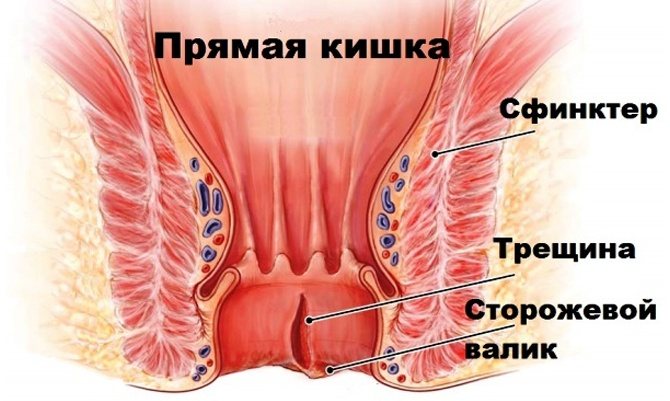
Rectal fissures are also possible due to constipation
What is Duphalac
Duphalac is a lactulose-based laxative that does not pass into breast milk, so it is absolutely safe for nursing mothers, it can be taken during pregnancy, and is prescribed by pediatricians and small children.
When lactulose enters the digestive tract, it breaks down into acids, attracts water - which causes pressure to increase, feces increase in volume, become soft, and the contractile activity of the intestinal walls is activated. Therefore, Duphalac helps normalize bowel movements without injury and discomfort, and cleanses the body of toxic substances.
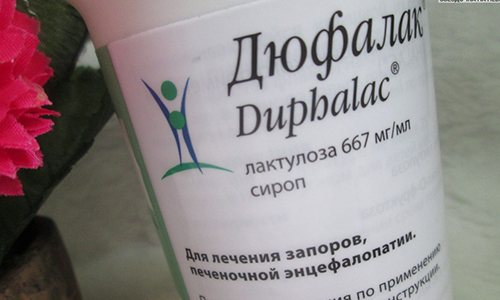
Lactulose promotes better absorption of calcium and phosphate salts, activates the growth of bifidobacteria and lactobacilli, and prevents the proliferation of pathogenic microorganisms.
According to reviews from women who took the drug during lactation, the medicine acts slowly, relief occurs within 24 hours, and with severe constipation, bowel movement can occur after 2 days.
Solution
To normalize intestinal function, you need to start from the leading causes. Possible exit routes:
- Establish a diet - eat meals in small portions, at the same time.
- Drink a sufficient amount of plain drinking water without gas, especially for nursing mothers, the total volume should be at least 1.5 liters per day.
- Give physical exercise to the muscles of the anterior abdominal wall after the end of the recovery period with the permission of the doctor and after a control ultrasound of the pelvic organs (in the normal course, this is after 4–6 months).
Psychological issues go away on their own after 1–2 months, sometimes it takes up to six months. The mother gets used to the baby, stops being so afraid and worried about him, and learns to combine her needs with caring for the baby. It’s good if during this period there are patient and understanding people nearby who can support the woman and give her self-confidence. This is what helps to overcome fears, psychological constipation ceases to manifest itself.
Method of using sea buckthorn suppositories for hemorrhoids
According to the instructions, sea buckthorn candles should be placed in the evening before bed. Rectal suppositories are recommended to be administered after a cleansing enema (stool). It is very important that the candle is inserted to the maximum possible depth. After the suppository has been inserted, the patient should lie quietly for half an hour. During this time, the product will be able to dissolve without problems.
Make sure that the drug does not cause discomfort or pain, as well as itching, burning, swelling or redness. Therapy lasts up to ten days on average.
Nutrition
What can a nursing mother eat?
Any products should be introduced into a woman’s diet gradually - one every 2-3 days. You need to watch how the baby reacts to them. It is important to understand that all children are different. If one mother's child does not respond to the variety of foods in her diet, then another will have very limited choices. The appearance of rashes, spots, and itching on the baby’s skin indicates the development of an allergy.
An approximate list of foods that a nursing woman needs to consume more often in order to help the intestines recover:
- fresh vegetables – cucumber, zucchini;
- stewed or fresh cabbage (cauliflower, white cabbage, broccoli), but in a very small volume, literally 3-5 tbsp. l.; if these vegetables do not lead to increased gas production in the child, then you can gradually increase the portion;
- prunes;
- wholemeal bread;
- bran, muesli with apple;
- sunflower oil with or without odor;
- butter;
- cottage cheese;
- fermented baked milk, kefir;
- buckwheat;
- liquid porridge with water;
- figs;
- vegetable soups with the addition of chicken or beef;
- apple compote.
It is useful to drink an infusion of fennel, anise, cumin, and a decoction of strawberry leaves.

Decoctions that are recommended to be taken to improve bowel function
Food should be boiled, stewed or steamed. Frying is not recommended. If there is a crust on the dish, then you should discard it. You need to eat warm, not cold food.
Diet for constipation for non-breastfeeding mothers
Since the child does not impose any restrictions on the menu, the optimal products, in addition to those already mentioned above, will be:
- pumpkin;
- boiled beets;
- carrot;
- plums;
- berries other than grapes - they give fermentation;
- lean meat;
- melon watermelon;
- fruit compote
Omelet and soft-boiled eggs are allowed. In general, you should adhere to the principles of diet No. 3.
What to exclude
Below is a list of foods and dishes that negatively affect intestinal function and lead to constipation in both nursing and non-breastfeeding women:
- sweet pastries, white bread;
- pasta;
- rice, semolina;
- fatty rich soups;
- tea, coffee, chicory;
- pears, pomegranate, persimmon, dogwood;
- grape;
- sauce, mayonnaise;
- horseradish, mustard;
- fried or hard-boiled eggs;
- smoked, spicy products, canned vegetables (except peas and beans).
Recipes for intestinal restoration after cesarean section
Examples of what dishes can be prepared for a nursing mother:
- Vegetable puree soup. Boil 300 g of zucchini, 1 onion, 2 small potatoes in a small amount of water until tender. Cool slightly, grind with a mixer. Season with salt and add 30 g of butter.
- Fruit salad. Slice 2 apples, sprinkle them with a handful of muesli, pour over plain yogurt.
- Steamed cutlets. Make a base of minced chicken and chopped raw zucchini in a ratio of 2 to 1, add finely chopped onion, salt, and a little pepper. If the mixture is a bit runny, add 1 egg and more minced meat. Mix everything. Form cutlets and cook in a double boiler.
- Curd soufflé. Beat 300 g of cottage cheese, 1 egg, 3 tbsp. l. sugar, 2 tbsp. l. flour. Add a handful of chopped prunes. Place in a mold, place in the oven for 20 minutes, desired temperature: 180°C. 5 minutes before it’s ready, add a piece of butter on top.

Vegetable puree soup and steamed cutlets are a good addition to the diet for intestinal restoration after cesarean section
Other ways to relieve and prevent constipation during breastfeeding
Against the background of prolonged and frequent constipation, a deficiency of vitamins and microelements develops, which negatively affects the quality of milk. Therefore, the task of every mother is to be able to prevent and properly treat constipation. The best way is to adjust your diet, move more, and try to avoid stress.
What foods can cause constipation:
- fast food, chips, crackers;
- rice and semolina porridge;
- caffeinated drinks;
- strawberries, pears, blueberries and currants;
- legumes;
- nuts;
- white bread, pastries;
- hard cheeses.
Despite the huge number of prohibitions and restrictions, gradually introduce vegetables and fruits into your diet - it is fiber that promotes regular bowel movements.
Effective and safe products for eliminating and preventing constipation are beets, carrots, pumpkin. They are hypoallergenic and will not cause a rash or diarrhea in your baby.
Kefir normalizes intestinal function well - drink a glass every evening before bed, and you will have problems with stool much less often.
Traditional medicine will also help regulate bowel movements - pour 250 ml of boiling water over 1 tbsp. l. chopped gooseberries, simmer the mixture over low heat for 10 minutes. Drink 50 ml strained 4 times a day.
Fresh potato juice relieves constipation well; it must be mixed in equal proportions with water - drink the medicine 55 ml 2-3 times a day half an hour before meals.
Physical exercise
After a cesarean section, a woman should get up the next day unless otherwise instructed by her doctor. Early activation activates the work of the intestines, since due to changes in body position, intra-abdominal pressure changes, and the abdominal muscles also begin to contract and relax.
During the first 3 months of caring for a child, you should not put additional stress on the body - postoperative wounds should heal well. If the stitches are in normal condition, as confirmed by ultrasound, and you have received permission from the doctor, you can begin light exercises, for example, using the Pilates system. The exercises performed should not cause discomfort or pain.
You can switch to a more productive mode six months after a caesarean section. Before this, you also need to perform an ultrasound to check whether the edges of the wound have fused so well, and visit a gynecologist.
Exercise helps not only activate intestinal function, but also reduce weight, which has a beneficial effect on a woman’s psycho-emotional state and improves her mood.
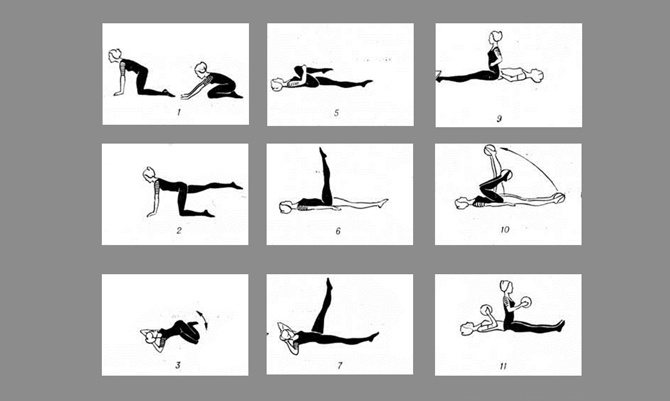
An example of physical therapy for constipation
Constipation, diarrhea after cesarean section. How to adjust a chair
Childbirth in women does not always occur naturally.
There are often situations in which doctors are forced to resort to caesarean section. The operation is quite complex, requiring some time for the woman to fully recover. As experts note, girls after a cesarean section have slightly more problems than women who gave birth naturally. In addition to the painful suture, there are added difficulties with defecation. Constipation can not only disturb a woman’s emotional background, but also cause poisoning of the body.
How many days have you been constipated?
Let's look at how to properly cope with constipation after a cesarean section with the help of drug therapy and proper nutrition.
Why are there problems with stool after cesarean section?
Problems with bowel movements after cesarean section in women are quite common. And the reason is not always nutrition. It's all about the anatomy of the intestine.
Let's look at the most common factors that lead to constipation after cesarean section:
- Psychological fear of harming yourself (possibility of seams coming apart). In this case, the woman is afraid to push. Feces cannot pass out. This leads to constipation. Solving the problem is quite simple. It is important that the doctor in the postoperative period explains to the woman how to go to the toilet correctly. At first, microenemas can greatly facilitate the task. They have a gentle effect on the intestines, softening stool.
- Physiological changes in the intestine. If the fetus is large, but in the last stages the uterus puts significant pressure on the intestines, the normal process of food digestion is disrupted. After birth, it will take time for peristalsis to return to normal. At the initial stage, special suppositories and other medications prescribed by a doctor can help.
- Poor nutrition. After abdominal surgery, a woman must follow a special diet. It lies in the fact that the foods consumed should not cause gas formation and should be easy to digest. Women themselves note that caring for a baby takes a lot of time, so they have to forget about proper nutrition. Snacking on sandwiches and snacks often occurs, which leads to constipation.
- Stool after cesarean section may change due to the fact that the gastrointestinal tract is slowed down. This phenomenon is not uncommon; literally 2-4 days after abdominal surgery everything will return to normal.
- The occurrence of hemorrhoids. This phenomenon is quite common among women in labor. In addition to difficulty defecating, the woman experiences bloody stool and bleeding in the anus.
- Cracks in the intestines. In this case, the stool may be black with an admixture of blood threads. In most cases, surgical intervention is not possible.
- Insufficient amount of fluid drunk. Maintaining water balance is an important point. Women after a caesarean section should drink at least 2 liters of water per day. This will not only improve intestinal motility, but also increase the amount of milk in a nursing mother.
Constipation after cesarean
Before treating constipation after cesarean section, the doctor must correctly determine its type. The most common type is atonic. Its features:
- the tone of the intestinal muscles is significantly reduced;
- metabolism is disrupted;
- food is not completely digested.
The following symptoms are characteristic of atonic constipation:
- Bloating. Gases are often observed, and the patient feels severe discomfort.
- A false feeling of fullness of the intestines is created. The woman feels like she has eaten too much.
- Pain appears in the abdominal area, which is aching or cramping in nature.
- Apathy and drowsiness sets in.
In severe cases, vomiting and increased body temperature may occur. In these situations, you cannot do without the help of a doctor.
If this type of constipation is not treated, a woman will develop hemorrhoids and cracks in the anus.
Spastic constipation is directly related to the unstable psycho-emotional state of a woman. The main reason is the fear of seams coming apart. At the same time, the tone of the intestinal muscles is fine, but peristalsis is rather sluggish.
The symptoms are as follows:
- The pain usually occurs in the left side of the abdomen. Is of a fickle nature.
- Flatulence and gas formation are often present.
- The woman feels bouts of nausea, sometimes to the point of vomiting.
- No appetite.
The passage of feces is difficult, although the urge to go to the toilet is frequent.
Cause of constipation
As we have already found out, the causes of constipation after childbirth can be psychological and physiological in nature. As a rule, the second option is more common.
What should a woman do if she has problems with bowel movements:
- First of all, do not self-medicate. In some cases, banal constipation can lead to intoxication and poisoning of the body. Often the solution to the problem requires surgery.
- Contact a gynecologist.
It is this specialist who will give further recommendations. If the problem is psychological in nature, a consultation with a psychologist will be scheduled. If a physiological problem arises, you cannot do without the help of a gastroenterologist and therapist. Sometimes a consultation with a surgeon is required.
After a cesarean section, constipation, alas, is not uncommon. But dealing with them is quite simple.
It is only necessary to identify the cause of difficult bowel movements in time and undergo the necessary treatment.
Treatment of constipation
Treatment of constipation after cesarean section should only be under the supervision of a specialist. As a rule, medications are prescribed.
It is important! If a woman is breastfeeding, you need to choose products with caution. Remember: not every drug is approved during lactation.
Recently, pharmaceuticals have offered a huge selection of remedies for constipation. Among them:
- various candles - many of them are plant-based, absolutely safe for mother and baby;
- microenemas - act quite “gently” and are not addictive;
- drugs that improve bowel function.
It is important! In addition to drug treatment, the patient is recommended to adhere to a special diet, stay hydrated, and do not forget about physical activity.
Diarrhea after caesarean section
Loose stools after cesarean section occur in 30% of women in labor. The phenomenon is quite unpleasant and dangerous and can lead to dehydration.
Before starting treatment, it is imperative to identify the cause of diarrhea. Perhaps the whole point is a physiological dysfunction of the intestines. This can be determined by the results of an ultrasound after a cesarean section, by taking a culture test and passing a number of other tests.
Cause of diarrhea
Possible causes of diarrhea after cesarean section are:
- Physiological process. If the fetus is large, then all the internal organs of the woman in labor (including the intestines) were in a compressed state for a long time. After delivery, everything falls into place. Therefore, it takes time for intestinal function to normalize.
- Psychological aspect. Happens quite often. Many women are so worried about their health that they invent a lot of diseases. This is what causes stomach upset. In this case, there are no other symptoms.
- Wrong diet.
- Poisoning. In this case, hospitalization and emergency treatment cannot be avoided.
- Dysbacteriosis Occurs when intestinal flora is disturbed. With the help of live lactobacilli and diet, eliminating the problem is quite simple.
- Allergy. It occurs quite often due to the use of medications and anesthesia during surgery. Antihistamines help quickly solve the problem.
Advice! If diarrhea (diarrhea) occurs, it is important to immediately consult a physician or gastroenterologist. If poisoning is detected, the mother must stop lactation so that the baby does not have similar problems.
Treatment of diarrhea
Diarrhea should be treated by a doctor. It is not recommended to take medications on your own. By doing this, you can harm not only yourself, but also the baby (if the mother is breastfeeding).
First of all, you need to find out the cause of diarrhea. In some cases, hospitalization and more detailed diagnosis of the patient’s condition may be necessary.
When to see a doctor
There are situations when you cannot hesitate:
- constipation during cesarean section lasts a long time;
- the woman feels a sharp, acute pain that does not go away even after taking analgesics;
- accompanying symptoms are observed: increased body temperature, vomiting, profuse sweating, loss of consciousness, refusal to eat;
- After going to the toilet, bloody discharge is observed on the underwear.
If these signs do not consult a doctor, unpleasant consequences may occur, including the formation of adhesions, cysts, and intestinal obstruction.
It can also lead to various diseases, tumors, hemorrhoids, gastritis, and intestinal deformities.
How to restore bowel function
After a caesarean section, ladies are often tormented by the question: “How to properly adjust the stool?” Don't be shy and hush up the problem. While in the hospital, you must inform your doctor about it.
To restore intestinal function, a specialist can recommend medication, diet, massage and much more.
Drug treatment
Live bacteria will help restore the functioning of the intestinal tract. Their advantage is that they are completely safe for the baby. Examples of drugs: “Linex”, “Biogaia”.
To improve the process of defecation, doctors recommend the following remedies:
- Syrups. The advantage of the drugs is that they contain lactulose. This substance has a good effect on the functioning of the intestines, removes stagnant feces, while softening them a little.
- Candles.
The downside is that these drugs are contraindicated for newborns. Therefore, if the mother is breastfeeding, you should refrain from using them. - Microclysters. Very comfortable and easy to use.
It is important! The use of any medications must be carried out under the strict supervision of a physician.
Nutrition, diet
Of course, you shouldn’t forget about proper nutrition. Foods that lead to constipation should be excluded from the mother's diet. Among them: rice, persimmon, white bread, eggplant, chocolate, pomegranate.
The diet should include fruits and vegetables. You are allowed to eat pineapple, melon, spinach, plum, zucchini, and tomatoes.
Don't forget about water balance. Minimum 1.5 liters of water per day. It is better to give up snacks and snacks. Eating on the go will not solve the problem, but will only make it worse.
Nutrition for constipation in adults should be balanced, rich in vitamins and minerals.
Folk remedies
Folk remedies for the treatment of constipation can only be used in parallel with the main treatment. Otherwise, you can get serious complications in the form of chronic intestinal and stomach diseases.
Traditional medicine can offer decoctions of anise and cumin, fennel, and figs. All of them are brewed according to the instructions written on their packaging.
It is important! If a mother is breastfeeding, it is better to forget about traditional medicine.
Doctors' opinion
According to doctors, constipation after cesarean section in many women is a common occurrence, observed in 50% of cases. If you do not pay attention to the problem in time, it can lead to serious consequences, including the need for surgical intervention.
How to prevent complications:
- contact a specialist in time;
- adjust the process of eating, eat often in small portions;
- exclude foods that cause constipation from the menu;
- do not self-medicate;
- follow the doctor's recommendations.
When breastfeeding a mother, as a rule, the process of defecation quickly improves. The thing is that a woman adheres to a certain, specially designed diet that helps the intestines work normally and smoothly.
Conclusion
Many women in labor experience a cesarean section. In most cases, such an operation helps save the life of mother and child.
This surgical intervention has a number of unpleasant features. One of them is constipation in women.
Retention of feces in the intestines often leads to complications, including the formation of adhesions, tumors, and complete obstruction. To prevent this from happening, you should not be afraid to seek medical help.
An experienced specialist will help quickly improve bowel function, without harm to the woman and her baby.
How much did the article help you?
Select number of stars
Average rating: / 5.
We're sorry this post wasn't helpful to you... We'll do better...
Let's improve this article!
Thank you very much, your opinion is important to us!
Source: https://kesarevo-sechenie.ru/posle-kesareva/zapor-ponos
Drug therapy
If you have constipation, you can resort to using rectal suppositories, for example, glycerin or sea buckthorn (they can be breastfeeding), but this should be done in extreme cases so that the intestines do not need constant stimulation in the future.
Another effective method is an enema, but its regular use has an even greater negative effect on bowel function than suppositories.
The main products used, approved for use in nursing mothers:
- "Lactulose";
- "Duphalac";
- "Fitomucil";
- "Forlax";
- Microlax.
Constipation after cesarean section requires an integrated approach, including normalization of nutrition, water balance, and adequate physical activity. Drug therapy must be agreed with your doctor.
Bowel problems after caesarean section
Most women who had a caesarean section experienced some problems with their intestines after surgery. The appearance of problems with stool after cesarean section is often associated with other postoperative complications, which only complicates the period of postpartum rehabilitation.
Why does constipation occur after cesarean section?
Patients often complain to doctors that an attempt to defecate ends in serious pain, which after a cesarean section can be caused by traumatic damage to the muscle tissue of the peritoneum. Sometimes the causes of pain come down to psychological factors, i.e.
The postpartum woman, due to fear of suture divergence, provokes a spasm of the anal muscles, which causes pain during bowel movements. Sometimes the causes of painful bowel movements are caused by a phenomenon such as constipation, which significantly spoils the first joy of motherhood and interferes with the passage of intestinal gases.
For some mothers, this problem persists for a fairly long postoperative period.
Experts name several reasons explaining the occurrence of this complication:
- Intestinal paresis, which is characterized by fading of intestinal activity and slowing of motor activity. This reaction of intestinal structures is quite logical and natural during surgical interventions in the abdominal cavity, especially with the use of general anesthesia. Additional signs of intestinal paresis are cramp-like painful sensations, lack of passage of feces and gases, uneven bloating of the abdominal area, etc. This condition is typical for the first postoperative days. A similar picture is not dangerous if observed in the first 3 days after a cesarean section, because even before the operation the woman is given a cleansing enema and is forbidden to eat during this period. Normally, postoperative emptying should be expected approximately on the third day of the postpartum period, and if this does not happen, then the woman is given an enema again.
- In the late postoperative stages, problems with the intestines can be caused by an adhesive process, which significantly worsens intestinal motility. Adhesions consist of the same tissues as scars, i.e. they have a connective tissue base. They are located between intraorganic structures in the abdominal localization and are a consequence of the protective reaction that occurs in the body to surgical intervention. Adhesions actually limit the possibility of inflammation spreading in the cavity where the intervention was performed. But even such seemingly good-intentioned adhesive processes have their drawbacks. The inelasticity and density of such adhesions leads to disruptions in the activity of the fused pelvic organs. Such fusion of the intestinal sections can lead to their obstruction, causing constipation, diarrhea, flatulence and other intestinal troubles.
Additional factors
If doctors have tried several ways to normalize stool and none of them gave the desired result, then there is every reason to assume the development of an active adhesive process, which can only be eliminated with the help of surgical manipulations.
However, in such an advanced form, such a phenomenon is quite rare.
Such fusion can be avoided through physical activity; the sooner the mother gets out of bed and moves, the sooner recovery will occur and adhesive processes will be prevented.
Another cause of constipation after cesarean section is weakened muscle tissue of the peritoneum, which is observed in all childbirths, regardless of their tactics. As a result, the patient cannot create the necessary pressure in the intestine to move stool.
But the most important factor in such a complication is the wrong approach to shaping the diet of a postpartum woman. Food like sandwiches and other dry foods cannot have a positive effect on intestinal motility, so with this approach, every attempt to defecate literally ends in torture.
The development of constipation can be triggered by excessively weakened muscles, hemorrhoids, lack of activity, low intestinal motility, insufficient water consumption and poor nutrition, change in the location of the intestines, etc.
Signs of a problem developing
As already mentioned, the cause of this problem is usually an incorrectly formulated and irregular diet. But if problems with bowel movements are accompanied by additional manifestations, then nutrition has nothing to do with it at all.
Such signs include the absence of bowel movements for 2 or more days.
Confirms the pathological etiology of constipation and discomfort in the left peritoneum or its cavity as a whole, flatulence, a feeling of fullness and distension of the intestinal structures.
A sign of serious constipation is pain and other difficulties with bowel movements such as too small or too large portions, etc. Belching, lack of appetite, nausea attacks, apathy and fatigue, irritability, soreness of the anus, cracks and bleeding from the anus - all this indicates a complex origin intestinal problem.
The clinical picture of constipation is determined by its form, of which there are 2 types: atonic and spastic. Atonic constipation is most typical for cesarean section. They have a rare desire to defecate.
Feces stagnate in the intestinal structures and harden, which is why subsequent release is accompanied by intense pain. Spastic constipation has psychological reasons for its development and is caused by the presence of intestinal bowel movements before the upcoming one.
The patient feels that if she strains, she may damage the postoperative sutures. Therefore, when you want to empty your bowels, spontaneous contraction of the sphincter occurs.
Danger of constipation
Constipation directly leads to the occurrence of anal fissures and hemorrhoids, so such conditions must be eliminated as soon as possible.
When hemorrhoids develop, various toxins penetrate into the resulting wounds. Where do they come from? From feces, in which they are formed due to prolonged intraintestinal retention.
From there, toxic substances enter the bloodstream and cause general organic intoxication.
Such conditions overload the liver, which immediately affects appearance and general health.
The woman is in a constant state of fatigue and exhaustion, her skin is pale, dry, and there may be signs of hair loss.
If in such a situation a woman breastfeeds her baby, then toxins with milk can enter his body. Therefore, problems with the intestines need to be resolved immediately after childbirth, before the onset of full lactation.
Ways to restore intestinal activity
To begin with, at the first signs of constipation, mom can try to solve the problem on her own. If you can’t cope with constipation, you will have to seek medical help, otherwise the body will suffer seriously due to the toxic effects.
Constant worry and discomfort in the intestines, painful sensations in the abdomen - all this steadily leads to a complete cessation of lactation and a worsening of the overall picture of the condition.
To restore full intestinal activity, traditional medications, nutritional correction and home tricks can be used.
Traditional medicine
The approach to treatment with traditional medications requires careful attention when prescribing drugs to lactating women, because not all of them are approved for use. In general, the following medications are prescribed:
- Fortrans or Forlax. Powder for the preparation of a drinking solution with the main active ingredient in the form of macrogol. The drug liquefies fecal deposits and promotes their natural release. Take in a dosage of 1 sachet per day.
- Duphalac, Normaze, Portalac. These are drugs containing a lactulose component that stimulate intestinal activity, soften and remove feces along with toxins. You need to take this drug in a dosage of 1-3 sachets per day.
If a woman does not breastfeed her baby, then medications such as Gutalax, Regulax, Dr. Theiss or Bisacodyl can be used for treatment.
You can also use rectal suppositories like Glycelax, suppositories with sea buckthorn, Calciolax or Ferrolax to treat stool. Suppositories are administered daily, following the instructions.
The main thing is not to overdo it, strictly following the recommended dosages, otherwise constipation can gradually turn into diarrhea, which is also a rather unpleasant condition.
Nutrition
During the postpartum recovery process, it is important to follow the principles of special dietary nutrition, which will help normalize all organic functions.
Such a diet involves eating foods enriched with fiber, for example, steamed vegetables, bran bread, dietary meat or dairy products. Water-based liquid porridges, kefir, oven-baked apples - all this should be eaten more often.
Olive oil also has a laxative effect. But fried foods and white bread should be avoided.
Home methods
There are many methods against constipation, which are based on the knowledge of traditional medicine. Decoctions of figs or mixtures of cumin, anise and fennel have a laxative effect.
Also helping to cope with constipation is a herbal mixture of components such as chamomile flowers and strawberries, mint and anise, and nettle leaves. But without fanaticism. You should definitely discuss the prescription with your doctor, because everything you eat or drink will enter your baby’s body.
When the seam heals and stops getting wet, you can perform a special massage for the abdominal area.
Prevention of constipation after surgical delivery
The postpartum mother needs to begin measures to prevent postoperative constipation even before transfer to the postpartum ward. To do this, it is recommended to drink sufficient volumes of liquid, which are at least 2 liters per day. Meals need to be planned by the hour. Taking boiled vegetables as the basis of the diet.
Start getting up as early as possible, such activity will help you recover faster. Constant exercise is also beneficial for the intestines, i.e. special exercises. You need to lie down on your right side, extend your lower limb, bend your upper limb at the knee and press it to your chest.
If you take this position more often, the intraintestinal pressure will increase, which stimulates intestinal activity.
There is no need to be ashamed of problems, even such delicate ones as constipation, because they may indicate adhesions, tumor processes or malignant intestinal obstruction.
Source: https://JdemBaby.com/rody/cesarean/problemy-so-stulom-posle-kesareva-secheniya.html
Storage conditions and shelf life
Please note that sea buckthorn suppositories begin to melt at fairly low temperatures, so they should not be stored in a cabinet with other medicines. To ensure that the drug remains safe and sound in the pharmaceutical packaging, it is recommended to store it in the refrigerator. The candle must be removed just before insertion.
If the suppository has been released from the blister, it can no longer be used or stored. Do not use the product after it has been exposed to extremely low or high temperatures.
The shelf life of sea buckthorn candles is about two years.
